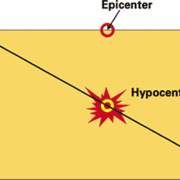Methods and Analysis
Methods and Analysis
Why does the USGS use the metric system instead of imperial units?
The metric system is the standard scientific measurement system used around the world (the United States is one of only three countries that have not adopted the metric system). Since the USGS is the science arm of the Department of the Interior and exchanges critical data with many global institutions, we also use the metric system. There are convenient online calculators that will quickly...
What reference datum is used for earthquake depths?
The USGS currently uses the WGS84 Geoid as the reference datum for earthquake depths. Other seismic networks might or might not use different methods. The choice of reference datum depends on the method used to locate the earthquake, which varies by seismic network. The Advanced National Seismic System Comprehensive Earthquake Catalog (ComCat) includes data from many different seismic networks, so...
What is a Geoid? Why do we use it and where does its shape come from?
A geoid is the irregular-shaped “ball” that scientists use to more accurately calculate depths of earthquakes, or any other deep object beneath the earth’s surface. Currently, we use the “WGS84” version (World Geodetic System of 1984). If Earth were a perfect sphere, calculations of depth and distances would be easy because we know the equations for those calculations on a sphere. However, the...
How can I make my own seismometer?
It is relatively easy to acquire the necessary materials and build your own seismometer. The links here are to various sources with information on how to build a seismometer. They range from very simple and inexpensive to sophisticated and pricey. Model Seismograph - Classroom Demonstration Build your own Seismograph Station Build Your Own Seismograph Amateur Seismology Homebuilt Seismograph FAQ
Seismometers, seismographs, seismograms - what's the difference? How do they work?
A seismometer is the internal part of the seismograph, which may be a pendulum or a mass mounted on a spring; however, it is often used synonymously with "seismograph". Seismographs are instruments used to record the motion of the ground during an earthquake. They are installed in the ground throughout the world and operated as part of a seismographic network. The earliest "seismoscope" was...
What was the first instrument that actually recorded an earthquake?
The earliest seismoscope was invented by the Chinese philosopher Chang Heng in A.D. 132. This was a large urn on the outside of which were eight dragon heads facing the eight principal directions of the compass. Below each dragon head was a toad with its mouth opened toward the dragon. When an earthquake occurred, one or more of the eight dragon-mouths would release a ball into the open mouth of...
How can an earthquake have a negative magnitude?
Magnitude calculations are based on a logarithmic scale, so a ten-fold drop in amplitude decreases the magnitude by 1. If an amplitude of 20 millimetres as measured on a seismic signal corresponds to a magnitude 2 earthquake, then: 10 times less (2 millimetres) corresponds to a magnitude of 1; 100 times less (0.2 millimetres) corresponds to magnitude 0; 1000 times less (0.02 millimetres)...
What does it mean that the earthquake occurred at a depth of 0 km? How can an earthquake have a negative depth; that would mean it’s in the air. What is the geoid, and what does it have to do with earthquake depth?
An earthquake cannot physically occur at a depth of 0 km or -1km (above the surface of the earth). In order for an earthquake to occur, two blocks of crust must slip past one another, and it is impossible for this to happen at or above the surface of the earth. So why do we report that the earthquake occurred at a depth of 0 km or event as a negative depth sometimes? First of all, the depth of an...
What was the duration of the earthquake? Why don't you report the duration of each earthquake? How does the duration affect the magnitude?
The duration of an earthquake is related to its magnitude but not in a perfectly strict sense. There are two ways to think about the duration of an earthquake. The first is the length of time it takes for the fault to rupture and the second is the length of time shaking is felt at any given point (e.g. when someone says "I felt it shake for 10 seconds" they are making a statement about the...
How do seismologists locate an earthquake?
When an earthquake occurs, one of the first questions is "where was it?" The location may tell us what fault it was on and where damage (if any) most likely occurred. Unfortunately, Earth is not transparent and we can't just see or photograph the earthquake disturbance like meteorologists can photograph clouds. When an earthquake occurs, it generates an expanding wavefront from the earthquake...
How are earthquakes recorded? How are earthquakes measured? How is the magnitude of an earthquake determined?
Earthquakes are recorded by a seismographic network . Each seismic station in the network measures the movement of the ground at that site. The slip of one block of rock over another in an earthquake releases energy that makes the ground vibrate. That vibration pushes the adjoining piece of ground and causes it to vibrate, and thus the energy travels out from the earthquake hypocenter in a wave...
How do you determine the magnitude for an earthquake that occurred prior to the creation of the magnitude scale?
For earthquakes that occurred between about 1890 (when modern seismographs came into use) and 1935 when Charles Richter developed the magnitude scale, people went back to the old records and compared the seismograms from those days with similar records for later earthquakes. For earthquakes prior to about 1890, magnitudes have been estimated by looking at the physical effects (such as amount of...













